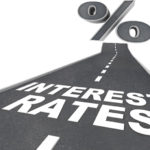
The Federal Reserve began raising its target federal funds rate at the end of 2015. Since then the target rate has been raised by 1%, or 100 basis points. But even though that target rate has been raised, it hasn’t really trickled down to consumers. Some consumer interest rates have been rising, but not all at the same rate, and that has real effects.
Credit Card Rates Rising Much Faster
Consumer interest rates haven’t risen 100 points yet, but the average rate on credit cards has risen 53 basis points since the Fed started raising its target rate. By comparison, interest rates on checking accounts have remained nearly stagnant. Checking account rates at banks with branches have risen on average by 8.85 basis points, while savings account rates have dropped 0.79 basis points. Interest rates at online-only banks have risen only 11.77 basis points. That means that banks are benefiting from the higher credit card interest rates to help pad their own profits, while their customers continue to suffer from historically-low interest rates.
It also means that the Federal Reserve will have a difficult time if it hopes to stimulate market interest rates to rise. There is so much uncertainty in the economy still that banks are happy to raise the interest rates they charge, not those they pay out. They’re still waiting to see where the Fed’s rate hikes end and what the stance of monetary policy is going forward in the long term before they start to pay out more money to depositors. Since the Fed seems to be taking its sweet time in normalizing monetary policy, it might be many, many more years before depositors even see one percent interest rates again on a regular basis.
Savings Accounts Are Not a Great Way to Save
More importantly, the continued low-interest rates on savings accounts make it abundantly clear, if it wasn’t already, that savings accounts are no way to save money, especially not for retirement. Because inflation is near two percent but savings accounts pay near zero, putting money into a savings account means that you are actually losing two percent of your savings’ purchasing power every year. Savings accounts have always had that drawback and the situation doesn’t appear likely to change anytime soon.
That’s why it is so important to have solid savings and investments that grow in value during your working years so that you can retire safely. A portfolio that is focused on wealth appreciation while you’re in the labor force and wealth protection during retirement is the best way to ensure that you’ll be able to enjoy your golden years.
One of the best ways to do that is to ensure that your portfolio invests not just in financial assets but also in precious metals such as gold and silver. Gold and silver have always served as safe havens in times of financial crisis, but they also perform well in a balanced portfolio to protect against inflation and ensure that your savings maintain their purchasing power well into your retirement. Don’t let your savings get eaten away, start putting gold and silver to work for you today.
The post Savings Rates Stagnant – Credit Card Rates Rising appeared first on Goldco.
No comments:
Post a Comment